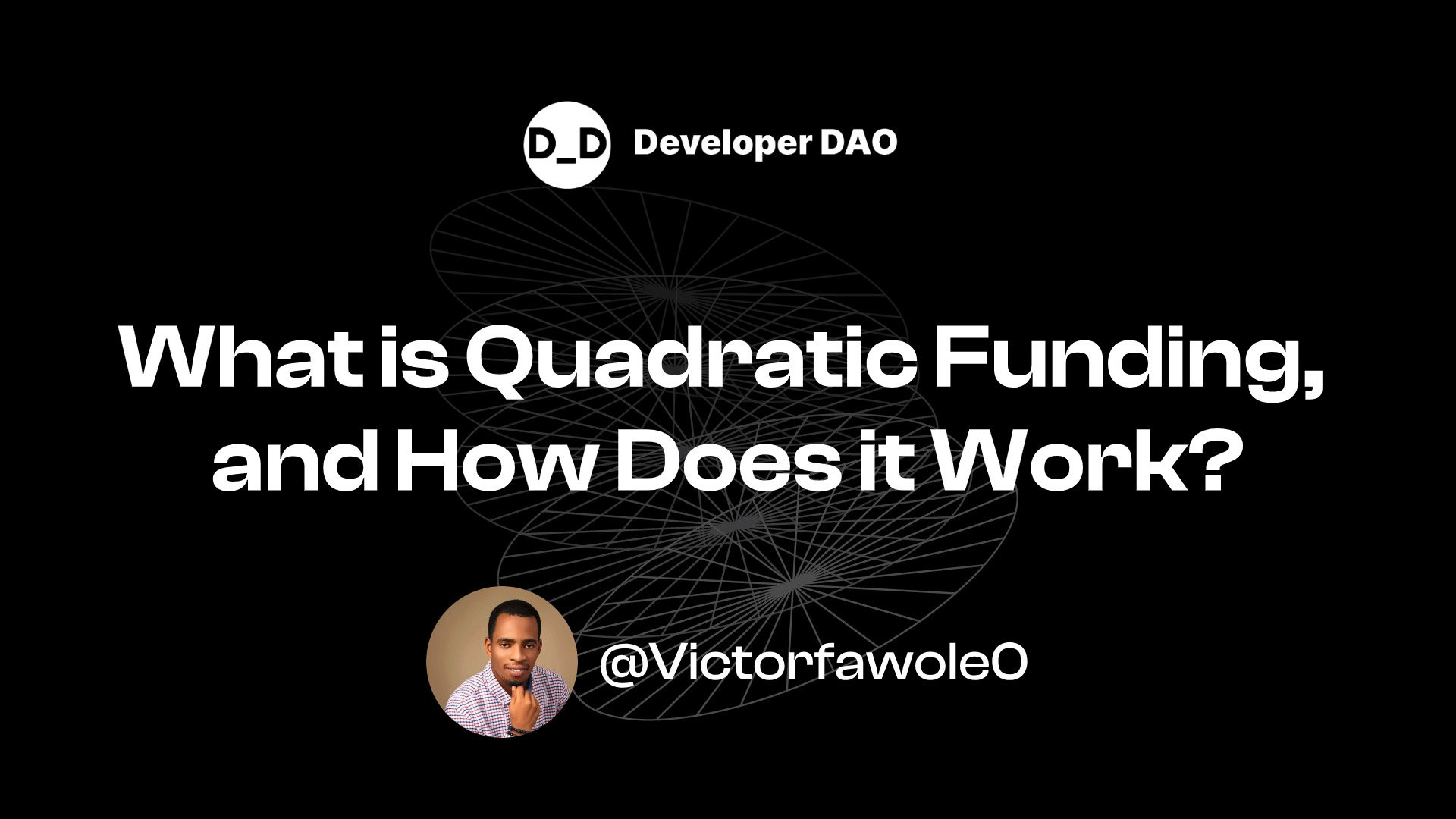What is Quadratic Funding, and How Does it Work?
 Victor Fawole
Victor FawoleTable of contents
- History of Quadratic Funding
- What is Quadratic Funding?
- Quadratic Funding: Empowering Small Contributors
- The Quadratic Funding Process Unveiled
- Practical Example: Mark's Open-Source Project
- How Does Quadratic Funding Improve Crowdfunding?
- Benefits of Quadratic Funding
- Demerits of Quadratic Funding You Should Know
- Blockchain Technology and the Future of Quadratic Funding
- Final Thought
- Frequently Asked Questions (FAQs)

The rich get richer every day, even when it comes to grant programs; however, Vitalik Buterin, the co-founder of Ethereum, thinks that for Web3 to be truly democratic, grant fundraising should also be democratic.
That brought a new dawn, a new way of raising funds that prioritizes the voice and needs of the majority over the minority big-holder investor.
Quadratic funding (QF) is the new way of fundraising in Web3. The time of crowdfunding is over!
In this article, you will learn the aim behind QF and the potential opportunities embedded in it.
Sit back and enjoy reading!
History of Quadratic Funding

We must first trace its origins to understand QF (a.k.a plural funding). Ethereum co-founder Vitalik Buterin envisioned it in collaboration with Zoë Hitzig and E. Glen Weyl from the idea of quadratic voting.
The driving force behind this concept was democratizing the grant fundraising process, challenging the narrative that only the wealthy should dictate the flow of financial support.
The journey began with a proposal paper laying the groundwork for a more democratic approach to crowdfunding. It aimed to address the rich-get-richer phenomenon in traditional grant programs, where major donors hold disproportionate influence.
What is Quadratic Funding?
QF is a democratic crowdfunding mechanism designed to ensure fair and inclusive funding for public goods. This approach would benefit public goods such as open-source software, scientific research, and public art projects.
Gitcoin,, a leading QF platform, defines this method as combining modest individual contributions with larger matching sums from sponsors or contributors.
It brings a novel perspective to crowdfunding by valuing widespread support over high donation amounts.
Quadratic Funding: Empowering Small Contributors
Unsplash: Hannah
QF operates on a fundamental principle: it democratically matches funds to benefit small contributors considerably.
This innovative model stands as a pillar of fairness and inclusivity, ensuring that resources for community projects are allocated based on collective support rather than the preferences of a privileged few.
Why does this matter?
QF is like the superhero of crowdfunding. It levels the playing field, ensuring even the smallest donor has a voice. No more one-size-fits-all matching – it's about amplifying community support.
Parties Involved:
- Every community member
- Large Donors
- Grantees (those seeking funding for a cause)
The Quadratic Funding Process Unveiled
Here's how QF works:
1. Create a Matching Pool
Initiating the process involves setting aside a matching pool of funds. This pool catalyzes amplifying individual contributions.
2. Community Support for Donations
The heart of QF lies in community involvement. The platform encourages individuals to contribute to public goods they value, irrespective of the amount. This widens the participation net, making it accessible to diverse contributors.
3. Quadratic Formula in Action
The unique aspect of QF is its application of a quadratic formula. This formula gives more weight to smaller contributions, leveling the playing field. It ensures that projects with more contributors receive more generous matching funds, even if each contributes modestly.
4. Distribution of Matching Funds
The matching funds, determined by the quadratic formula, are then distributed to public goods. This mechanism guarantees a more equitable allocation of funds based on community preferences, fostering an environment where projects gain support not solely based on their size but on their broad appeal.
Practical Example: Mark's Open-Source Project
Consider Mark, a developer with a vision for an open-source project enhancing online privacy. Launching his campaign on a QF platform (Gitcoin), Mark welcomes support from a diverse community.
Even small contributors who believe in his vision significantly impact the project thanks to the quadratic incentives.
For instance, a hundred contributors, each donating $1, could receive more matching funds than ten contributors, each donating $10.
The quadratic formula's magic lies in recognizing the widespread support that Mark's project garners, irrespective of individual contribution size.
This real-world example showcases how QF goes beyond the traditional fundraising model. It empowers projects like Mark's, which may lack backing from major funders, by democratizing the allocation of resources and emphasizing community-driven decision-making.
This way, QF catalyzes innovation and supports projects that resonate with a broader audience.
How Does Quadratic Funding Improve Crowdfunding?
QF improves crowding funding in many ways; here are a few.
Democratizing the Funding Landscape
QF disrupts conventional crowdfunding norms by introducing a democratic and inclusive approach. Unlike traditional methods favoring large donors, this model places significance on the number of contributors.
In essence, it shifts the power dynamic, ensuring that each voice, regardless of financial capacity, plays a crucial role in determining the allocation of funds.
Incentivizing Modest Contributions
The core strength of QF lies in its ability to incentivize a multitude of modest donations.
Doing so breaks away from the trend observed in traditional fundraising, where a limited number of significant contributions from affluent individuals or organizations tend to dominate.
This shift in focus encourages a broader spectrum of supporters, fostering a community-driven ethos where every contributor, irrespective of the donation size, contributes meaningfully to the cause.
Countering Funding Concentration
Traditional crowdfunding often concentrates funds on well-known or already successful projects. QF disrupts this pattern by rewarding projects with widespread support. The quadratic formula matches contributions many people make more generously than those made by fewer individuals. This counteracts the rich-get-richer phenomenon, promoting diversity and inclusivity in the distribution of funds.
Fostering Diversity and Fairness
QF places a premium on community support, resulting in a fairer distribution of resources for public goods. It inherently values diversity in terms of the number of contributors and the types of projects that receive support. Smaller projects, which might not have the backing of major funders but are nonetheless significant to the community, stand to benefit significantly.
This emphasis on fairness and inclusivity sets QF apart as a transformative force in crowdfunding.
Transparency and Community Involvement
QF aligns with the principles of decentralization and community involvement. The transparent nature of the process, coupled with visible fund allocation, builds trust and confidence among contributors. It ensures that decisions are made collaboratively, based on community preferences, rather than being swayed by the interests of a small group of affluent donors.
Benefits of Quadratic Funding
Encourages a Wide Variety of Contributors
QF encourages diverse participation by providing matching funds for small contributions, irrespective of financial resources.
Incentivizes High-Quality Work
It motivates contributors to produce high-quality work, rewarding projects that generate positive feedback from the community.
Reduces Influence of Large Donors
QF lessens the impact of wealthy donors, ensuring a more representative distribution of funds based on community support.
Supports Transparency
Platforms utilizing QF can enhance transparency by clearly illustrating how they distribute donations, building public confidence.
Democratizes Decision-Making
The democratic nature of QF ensures that decisions are made based on widespread community support rather than the preferences of a few affluent individuals.
Demerits of Quadratic Funding You Should Know
Difficulty in Measuring Impact
Measuring impact can be challenging and arbitrary, making it difficult to distribute resources wisely.
Possibility for Abuse
Dishonest individuals may use the system through forged donations or collusion.
Lack of Diversity
Biases and preferences of the larger community may still influence public goods funded through QF.
Need for Infrastructure and Resources
Establishing a QF system requires significant infrastructure and investment, limiting accessibility.
Impact Determination Challenges
The system may need help accurately determining the impact of funded projects, which could make assessing success difficult.
Blockchain Technology and the Future of Quadratic Funding
Looking ahead, blockchain technology is poised to play a major role in improving the effectiveness and efficiency of QF.
Blockchain offers a secure, open, unchangeable record of donations and funding distributions. Smart contracts can automate the funding process, ensuring equitable and transparent distribution of funds.
The decentralization enabled by blockchain can increase the accessibility of QF, supporting smaller, less-resourced groups and fostering the participation of diverse communities.
Tokens representing contributions can streamline fund tracking and transfer, giving donors a tangible representation of their commitment to a project.
List of projects using QF:
- Gitcoin
- Ethereum
- Pomelo
- Giveth
- Supermodular
- Endaoment
Final Thought
QF is a transformative force in crowdfunding, championing community involvement, fairness, and inclusivity. Gitcoin Grants is already rocking this, raising over $4 Million in Ethereum communities. As it continues to gain traction, its potential impact on public goods projects. While challenges exist, the innovative nature of QF positions it as a dynamic and evolving model with promising prospects. Its uniqueness lies in prioritizing the number of supporters rather than the highest monetary value.
Say goodbye to traditional crowdfunding: QF is the innovative way forward in Web3.
Frequently Asked Questions (FAQs)
What principle underpins QF?
QF prioritizes widespread support over substantial donations, fostering a democratized crowdfunding process where community participation takes precedence.
How does blockchain technology enhance the effectiveness of QF?
Blockchain is the cornerstone by providing a secure and transparent ledger for recording donations.
Simultaneously, smart contracts automate the intricate funding distribution process, thereby increasing operational efficiency and mitigating the risks associated with potential abuse.
What are the primary advantages associated with QF?
QF offers a multifaceted array of benefits. It encourages a diverse spectrum of contributors and acts as a catalyst for high-quality work.
Additionally, it diminishes the disproportionate influence of large donors, promotes transparency in fund allocation, and embodies a democratic decision-making approach.
What challenges does QF encounter?
The challenges encompass measuring impact, mitigating the potential for abuse, addressing the lack of diversity in funded projects, securing the necessary infrastructure and resources, and accurately determining the effect of funded initiatives. Each presents a nuanced aspect contributing to QF's complexities in its implementation and sustainability.
Subscribe to my newsletter
Read articles from Victor Fawole directly inside your inbox. Subscribe to the newsletter, and don't miss out.
Written by

Victor Fawole
Victor Fawole
I am a passionate web3 technical writer who is curious about the web3 space. A person with a deep understanding of web3 content marketing. I create educational, informative, and engaging web3 content. I love writing on anything web3💕💕
